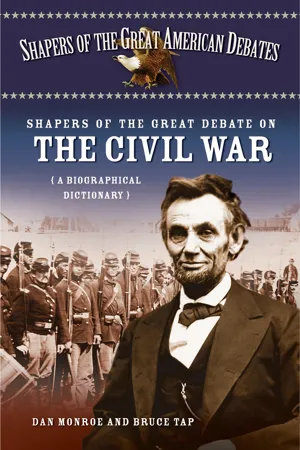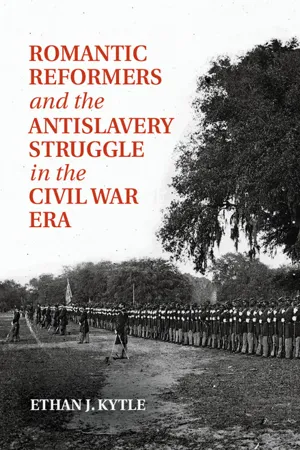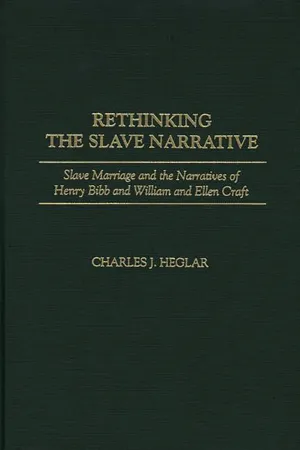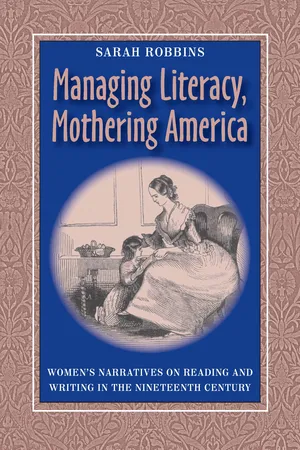History
Harriet Beecher Stowe
Harriet Beecher Stowe was an influential American author and abolitionist known for her novel "Uncle Tom's Cabin," which depicted the harsh realities of slavery and played a significant role in shaping public opinion on the issue. Her work sparked widespread debate and activism, contributing to the growing anti-slavery movement in the United States during the 19th century.
Written by Perlego with AI-assistance
Related key terms
1 of 5
5 Key excerpts on "Harriet Beecher Stowe"
- eBook - ePub
Slavery, War, and a New Birth of Freedom
1840s-1877
- Jeffrey H. Hacker(Author)
- 2014(Publication Date)
- Routledge(Publisher)
Stowe, Harriet Beecher (1811–1896)Author and activist Harriet Beecher Stowe is best known for her powerful antislavery novel Uncle Tom's Cabin (1852), an enormously popular work that gave millions of Americans their first view of the slave experience through the eyes of those in bondage. The book and stage adaptation changed the popular perception of slavery energized the abolitionist movement, and pushed the nation closer to civil war.She was born Harriet Elizabeth Beecher on June 14, 1811, in Litchfield, Connecticut. Her father, Lyman Beecher, was a renowned Presbyterian minister as well as an activist for the temperance and abolitionist causes. Her mother, Roxana Foote Beecher, died when Harriet was 5 years old. Many of the Beecher children achieved prominence, among them Harriet’s sister Catharine Beecher, a noted educator; brothers Henry Ward Beecher and Charles Beecher, both Congregationalist ministers and social reformers active in the abolitionist movement; and sister Isabella Beecher Hooker, a leader in the woman suffrage movement. Harriet studied and later taught at Hartford Female Seminary, which was founded and operated by her sister Catharine. In 1832, her father accepted the presidency of Lane Theological Seminary, and the family moved to Cincinnati, Ohio. There, Harriet met and married Calvin Stowe, a minister and professor at Lane.Six of the Stowes’ seven children were born during their years in Cincinnati. It also was during this time that slavery became more than an abstract concept for the Beecher family. Although Lyman Beecher had preached against slavery throughout his career, living just across the Ohio River from the slave state of Kentucky gave Harriet and the rest of the family firsthand experience with the institution. The Beechers grew even more vocal in their opposition to slavery and became active in the Underground Railroad. - eBook - PDF
Shapers of the Great Debate on the Civil War
A Biographical Dictionary
- Dan Monroe, Bruce Tap(Authors)
- 2005(Publication Date)
- Greenwood(Publisher)
9 CONCLUSION Harriet Beecher Stowe brought home the horrors of slavery to the people of the North, employing familiar themes that enabled whites to empathize with the slaves and to thereby acknowledge the humanity of those who suf- fered under the slavery system. Stowe's broadside had greater impact be- cause women were popularly regarded as the moral watchdogs of home and community. Though condemned by later critics, her novel Uncle Tom's Cabin retains the power to move readers, and it provides a window into a time in American history when men and women fled bondage across icy rivers and through darkened forests and fields. NOTES 1. This essay is based on the following sources: Joan D. Hedrick, Harriet Beeche Stowe: A Life (New York: Oxford University Press, 1994); Joan D. Hedrick, ed., The Oxford Harriet Beecher Stowe Reader (New York: Oxford University Press 1999); Kathryn Kish Sklar, Catharine Beecher: A Study in American Domestici (New York: W.W. Norton, 1976); and Charles Edward Stowe and Lyman Beecher Stowe, Life of Harriet Beecher Stowe: The Story of Her Life (Boston: Houghton Mifflinand Co., 1911). 2. Hedrick, Harriet Beecher Stowe, 64. 3. Hedrick, Harriet Beecher Stowe, 140. Harriet Beecher Stowe 275 4. Hedrick, Harriet Beecher Stowe, 109. 5. Hedrick, Harriet Beecher Stowe, 193. 6. Harriet Beecher Stowe to Catharine Beecher, n.d. [1850 or 1851], in Joan Hedrick, ed., The Oxford Harriet Beecher Stowe Reader (New York: Oxford Uni- versity Press, 1999), 61. 7. Harriet Beecher Stowe to Henry Ward Beecher, February 1, 1851, in Hedrick, Stowe Reader, 65. 8. "Will You Take a Pilot?" in Hedrick, Stowe Reader, 472. 9. "What Is a Home?" in Hedrick, Stowe Reader, 493. F U R T H E R READING Joan D. Hedrick, Harriet Beecher Stowe: A Life (New York: Oxford University Press, 1994); idem., ed., The Oxford Harriet Beecher Stowe Reader (New York: Oxford University Press, 1999); Leonard L. - Ethan J. Kytle(Author)
- 2014(Publication Date)
- Cambridge University Press(Publisher)
Taken together, these heroic archetypes – the sentimental martyr and the resistant rebel – reveal Stowe’s ambivalent, multilayered, antislavery thinking. 8 Liberator, Feb. 25, 1853. 9 HBS, Uncle Tom’s Cabin: Or, Life Among the Lowly (1852; repr., New York: Viking, 1981), 624. Romantic Reformers 118 Ambivalence, to be sure, was not unreasonable in a tumultuous age. But Stowe had a particularly acute case. The daughter of Lyman Beecher, perhaps the most influential preacher of the early nineteenth century, she was, on the one hand, the product of her father’s modified Calvinism. Quick to minimize her own agency, Stowe gave credit to a higher source for Uncle Tom’s Cabin. On the other hand, her novel stressed not the awe- some power of God but rather the ways in which Christians who opened their hearts to Jesus Christ could almost become divine themselves. This message reflected an altogether different context – what Emerson called “the age of the first person singular” – in which somber Calvinist notions of original sin and a limited elect seemed anachronistic holdovers from a bygone era. 10 Viewed this way, Uncle Tom’s Cabin spoke directly to perfectionist America. Unlike her fellow New Romantics, however, Stowe had doubts about the demands of perfectionist striving as well as the likelihood of achiev- ing a state of spiritual perfection. She had misgivings as well about her lifelong interest in popular and elite romantic currents. As a young girl, Stowe had plowed through the works of Byron and Scott, which both tantalized and disturbed her. After befriending Byron’s widow, she wrote a scathing essay to excoriate the English poet for his incestuous infi- delity. 11 In similar fashion, Stowe was drawn to – and repelled by – the religious theories of German Romantics such as Schleiermacher and Schelling and their Transcendentalist counterparts.- eBook - PDF
Rethinking the Slave Narrative
Slave Marriage and the Narratives of Henry Bibb and William and Ellen Craft
- Charles J. Heglar(Author)
- 2001(Publication Date)
- Praeger(Publisher)
Stowe's combination of sentimental domestic themes, especially those centering on motherhood, and episodes borrowed from the slave narratives captured the imagination of the West- ern world. Sales of the novel were phenomenal; in 1852, the first year the two-volume book-length version was available, more than 300,000 copies were sold. As Jane Tompkins notes, Uncle Tom's Cabin "was the first Ameri- 112 Rethinking the Slave Narrative can novel ever to sell a million copies and its impact is generally thought to have been incalculable" (124). Because of the increased tensions of the 1850s with the passage of a more stringent Fugitive Slave Law, John Brown's attack on Harper's Ferry, and the outbreak of the Civil War in 1861, contemporaneous commentators were so busy with the actual that they had very little time to remark on black fiction. However, the assumption of the "incalculable" impact of Un- cle Tom's Cabin became widespread in twentieth-century studies of African American literature. For example, Vernon Loggins and Sterling Brown claim that Stowe's success encouraged and served as the model for African American authors who moved from the autobiographical constraints of the slave narrative to the fictionalized freedom of the novel by means of their imitations of Stowe's work (Loggins 167, 186; S. Brown 40-41). In later criticism, scholars have modified this position and noted that African American authors revised Stowe's characters, rather than blindly imitated them, in their fiction. For instance, in "Sharing the Thunder" (1982), Stepto suggests that Douglass' fictionalization of Madison Washington is an amalgam of Stowe's Uncle Tom and George Harris (143). Richard Yarborough points out the problem presented by Stowe's novel: "Stowe's work played a major role of establishing the level of discourse for the majority of fictional treatments of the Afro-American that were to fol- low—even for those produced by blacks themselves" ("Strategies" 46). - eBook - ePub
Managing Literacy Mothering America
Womens Narratives On Reading And Writing
- Sarah Robbins(Author)
- 2009(Publication Date)
- University of Pittsburgh Press(Publisher)
36 Similarly, Stowe’s white women readers would have been able to identify with his indirect exercise of influence over Augustine St. Clare and the slave community at Legree’s plantation through literacy-based learning from George and Eva. But basing Tom’s claim to social agency in this highly gendered model also paved the way for future representations of his character (e.g., in plays, illustrations, and statuettes) as weak at best—particularly since the efficacious aspects of the feminized literacy manager role became less familiar to American readers over time, as domestic literacy narratives’ discursive patterns and ideology faded from cultural memory.Perhaps one way to help today’s readers access Uncle Tom’s Cabin in its own cultural context is to expand our focus beyond Tom to other characters marked by Stowe’s adoption of the domestic literacy narrative. One of these is Mrs. Shelby, on stage for brief periods but ideologically significant, given the novel’s generic heritage. Working indirectly through her son George, Mrs. Shelby can be seen as another of Tom’s motherly teachers and, like Tom, a motherly teacher for the reader. Also like Tom, Mrs. Shelby is quite limited in her own access to social agency and must stake her best hope for a more moral society in the “rising generation” represented by George. As Stowe explains in her Key, although technically a member of the plantation class, Mrs. Shelby tries to resist its misplaced values. Stowe pointedly credits her commitment to morality-linked education, to the extent possible in a constrained situation. And just in case the novel’s first audience had missed the sympathetic components of the character, Stowe describes Mrs. Shelby in the Key asof the very best class of Southern women; and while the evils of the institution [of slavery] are felt and deplored, and while the world looks with just indignation on the national support and patronage which is given to it, and on the men who . . . deliberately make efforts to perpetuate and extend it, it is but justice . . . [to] bear in mind the virtues of such persons. Many of them, surrounded by circumstances over which they can have no control, perplexed by domestic cares of which women in free states can have very little conception, loaded down by duties and responsibilities which wear upon the very springs of life, still go on bravely and patiently from day to day, doing all they can to alleviate what they cannot prevent and, as far as the sphere of their own immediate power extends, rescuing those who are dependent upon them from the evils of the system. (12)
Index pages curate the most relevant extracts from our library of academic textbooks. They’ve been created using an in-house natural language model (NLM), each adding context and meaning to key research topics.




